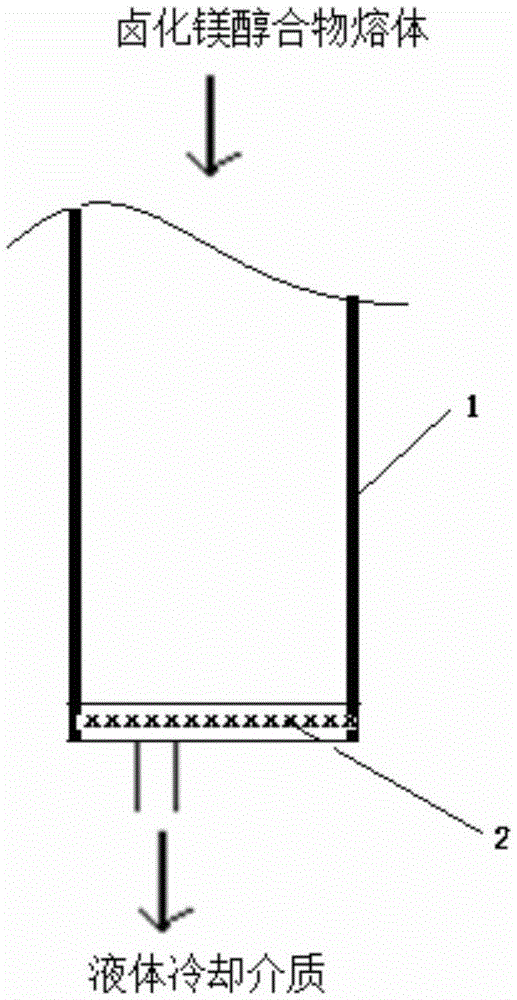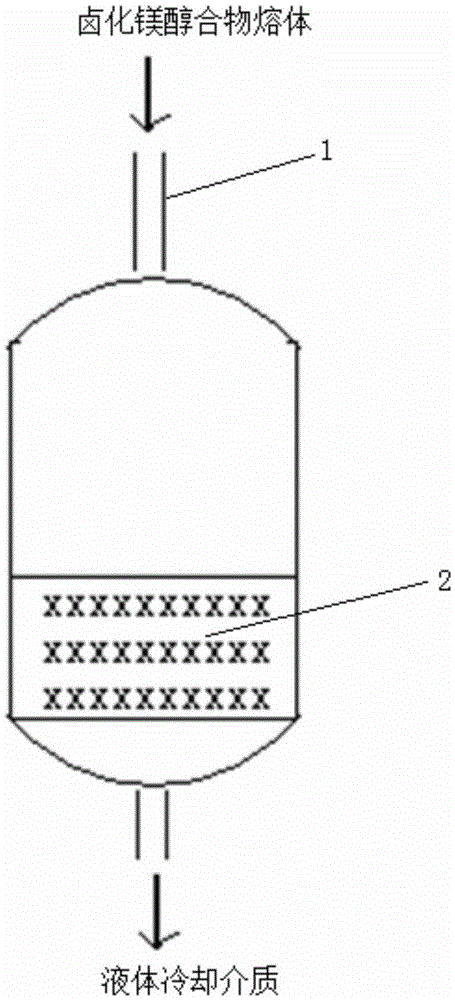Catalyst component for olefin polymerization, preparation method and application thereof, catalyst for olefin polymerization and application thereof
A technology of olefin polymerization and catalyst, which is applied in the field of catalyst components and its application in olefin polymerization reaction, can solve the problems of small particle size support, poor regularity of large particle size support, etc., and achieve good hydrogen adjustment sensitivity and /or Stereotropic, improved repeat stability, convenient and easy to change production
- Summary
- Abstract
- Description
- Claims
- Application Information
AI Technical Summary
Problems solved by technology
Method used
Image
Examples
preparation example Construction
[0046] As mentioned above, the present invention provides a method for preparing a catalyst component for olefin polymerization, the method comprising: carrying out a contact reaction with a magnesium halide alcoholate carrier, a titanium compound and an internal electron donor, the internal donor The electron body contains a diether compound; the preparation step of the magnesium halide alcoholate carrier includes: under pressure, the magnesium halide alcoholate melt passes through a structural unit with holes to contact with a liquid cooling medium.
[0047] According to the method of the present invention, preferably, the pressurizing conditions include: the pressure is 0.05-1 MPa, more preferably 0.1-0.5 MPa, further preferably 0.2-0.5 MPa. By using the preferred pressure, the particle size and size distribution can be further optimized, and at the same time, the olefin polymerization catalyst prepared on the carrier has the advantages of high hydrogen modulation sensitivit...
Embodiment approach
[0053] According to a preferred embodiment of the present invention, the structural unit with holes is a mesh layer.
[0054] According to the method of the present invention, the adduct solid particles with equivalent particle morphology can be obtained by adopting the metal mesh with multi-layer large-aperture structure and the metal mesh with relatively small number of layers with small-aperture structure. When preparing small particle size (such as less than 30 μm) adduct carrier, it is preferable to use a metal mesh structure with 1-20 layers of small pore structure (such as pore size of 30-50 μm). It is preferred to use a metal mesh structure with 1-20 layers of relatively large aperture (eg, 65-200 μm aperture) structure.
[0055] According to a preferred embodiment of the present invention, the mesh layer includes 1-20 layers, preferably 2-8 layers; the thickness of each layer is 0.01-0.35mm, preferably 0.05-0.25mm, more preferably 0.1-0.15mm mm.
[0056] According t...
preparation Embodiment 1
[0129] In a 1L autoclave, add 500ml of silicone oil, 30g of magnesium chloride, and 50ml of ethanol, raise the temperature to 125°C with stirring, and stir at 125°C for 3 hours. The metal mesh (each layer thickness 0.1mm) is directly placed in 3L hexane pre-cooled to -30°C, the liquid is filtered off, the solid is washed three times with hexane, and dried in vacuum to obtain 50 grams of spherical magnesium chloride alcoholate solid particles S1, the alcohol / magnesium molar ratio is 2.6, and the characterization results are shown in Table 1.
PUM
| Property | Measurement | Unit |
|---|---|---|
| pore size | aaaaa | aaaaa |
| pore size | aaaaa | aaaaa |
Abstract
Description
Claims
Application Information
 Login to View More
Login to View More - R&D
- Intellectual Property
- Life Sciences
- Materials
- Tech Scout
- Unparalleled Data Quality
- Higher Quality Content
- 60% Fewer Hallucinations
Browse by: Latest US Patents, China's latest patents, Technical Efficacy Thesaurus, Application Domain, Technology Topic, Popular Technical Reports.
© 2025 PatSnap. All rights reserved.Legal|Privacy policy|Modern Slavery Act Transparency Statement|Sitemap|About US| Contact US: help@patsnap.com



